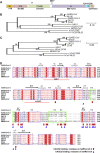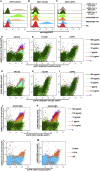Structural and Functional Basis of SARS-CoV-2 Entry by Using Human ACE2
- PMID: 32275855
- PMCID: PMC7144619
- DOI: 10.1016/j.cell.2020.03.045
Structural and Functional Basis of SARS-CoV-2 Entry by Using Human ACE2
Abstract
The recent emergence of a novel coronavirus (SARS-CoV-2) in China has caused significant public health concerns. Recently, ACE2 was reported as an entry receptor for SARS-CoV-2. In this study, we present the crystal structure of the C-terminal domain of SARS-CoV-2 (SARS-CoV-2-CTD) spike (S) protein in complex with human ACE2 (hACE2), which reveals a hACE2-binding mode similar overall to that observed for SARS-CoV. However, atomic details at the binding interface demonstrate that key residue substitutions in SARS-CoV-2-CTD slightly strengthen the interaction and lead to higher affinity for receptor binding than SARS-RBD. Additionally, a panel of murine monoclonal antibodies (mAbs) and polyclonal antibodies (pAbs) against SARS-CoV-S1/receptor-binding domain (RBD) were unable to interact with the SARS-CoV-2 S protein, indicating notable differences in antigenicity between SARS-CoV and SARS-CoV-2. These findings shed light on the viral pathogenesis and provide important structural information regarding development of therapeutic countermeasures against the emerging virus.
Keywords: ACE2; CTD; SARS-CoV-2; crystal structure; immunogenicity; receptor; receptor binding domain.
Copyright © 2020 Elsevier Inc. All rights reserved.
Conflict of interest statement
Declaration of Interests The authors declare no competing interests.
Figures









Similar articles
-
Structure of the SARS-CoV-2 spike receptor-binding domain bound to the ACE2 receptor.Nature. 2020 May;581(7807):215-220. doi: 10.1038/s41586-020-2180-5. Epub 2020 Mar 30. Nature. 2020. PMID: 32225176
-
Receptor Recognition by the Novel Coronavirus from Wuhan: an Analysis Based on Decade-Long Structural Studies of SARS Coronavirus.J Virol. 2020 Mar 17;94(7):e00127-20. doi: 10.1128/JVI.00127-20. Print 2020 Mar 17. J Virol. 2020. PMID: 31996437 Free PMC article.
-
Structural basis of receptor recognition by SARS-CoV-2.Nature. 2020 May;581(7807):221-224. doi: 10.1038/s41586-020-2179-y. Epub 2020 Mar 30. Nature. 2020. PMID: 32225175 Free PMC article.
-
Mass Spectrometry and Structural Biology Techniques in the Studies on the Coronavirus-Receptor Interaction.Molecules. 2020 Sep 10;25(18):4133. doi: 10.3390/molecules25184133. Molecules. 2020. PMID: 32927621 Free PMC article. Review.
-
The SARS-CoV-2 Spike Glycoprotein as a Drug and Vaccine Target: Structural Insights into Its Complexes with ACE2 and Antibodies.Cells. 2020 Oct 22;9(11):2343. doi: 10.3390/cells9112343. Cells. 2020. PMID: 33105869 Free PMC article. Review.
Cited by
-
Evaluation of Angiotensin-Converting Enzyme 2 Expression In Vivo with Novel 68Ga-Labeled Peptides Originated from the Coronavirus Receptor-Binding Domain.ACS Pharmacol Transl Sci. 2024 Sep 12;7(10):3119-3130. doi: 10.1021/acsptsci.4c00316. eCollection 2024 Oct 11. ACS Pharmacol Transl Sci. 2024. PMID: 39416971
-
In Silico Design of miniACE2 Decoys with In Vitro Enhanced Neutralization Activity against SARS-CoV-2, Encompassing Omicron Subvariants.Int J Mol Sci. 2024 Oct 8;25(19):10802. doi: 10.3390/ijms251910802. Int J Mol Sci. 2024. PMID: 39409131 Free PMC article.
-
The accomplices: Heparan sulfates and N-glycans foster SARS-CoV-2 spike:ACE2 receptor binding and virus priming.Proc Natl Acad Sci U S A. 2024 Oct 22;121(43):e2404892121. doi: 10.1073/pnas.2404892121. Epub 2024 Oct 14. Proc Natl Acad Sci U S A. 2024. PMID: 39401361
-
A circularly permuted CasRx platform for efficient, site-specific RNA editing.Nat Biotechnol. 2024 Oct 9. doi: 10.1038/s41587-024-02430-w. Online ahead of print. Nat Biotechnol. 2024. PMID: 39385008
-
Analysis of Fetal Growth and Pregnancy Outcome in Pregnant Women Infected with Novel Coronavirus in Mid-Pregnancy.Int J Womens Health. 2024 Oct 1;16:1625-1631. doi: 10.2147/IJWH.S480448. eCollection 2024. Int J Womens Health. 2024. PMID: 39372668 Free PMC article.
References
-
- Azhar E.I., El-Kafrawy S.A., Farraj S.A., Hassan A.M., Al-Saeed M.S., Hashem A.M., Madani T.A. Evidence for camel-to-human transmission of MERS coronavirus. N. Engl. J. Med. 2014;370:2499–2505. - PubMed
Publication types
MeSH terms
Substances
LinkOut - more resources
Full Text Sources
Other Literature Sources
Molecular Biology Databases
Miscellaneous

